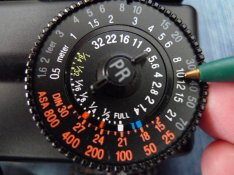At 58 I would assume (hope!) it's in metres - I have a couple similar-sized Minolta flashes (5600) that are 56m at ISO100 at full zoom (80mm). If it's 58 feet, it's a totally pissweak flash that's not worth using for medium format and there is no way it will give enough light. For a constant beam pattern, a flash with 56m GN has 9x (more than 3 stops!) more power than a flash with 56' GN.
Anyway, Guide Numbers are useful only for calculating exposure when directly illuminated by the flash; they are not useful for calculating exposure through a light modifier like an umbrella or softbox. The reason is that the GN tells you the angular flux density of light, i.e. number of photons passing through a particular subject area and therefore (when divided by distance) give you a measure of the light intensity falling on your subject. They do not tell you the total number of photons available (net flux, generally measured using electrical Ws = J as a proxy), which is what you need to know when using a modifier.
Note that they quote GN at maximum zoom on the flash, i.e. with a very narrow beam. If you widen the beam (zoom the flash out), the GN reduces dramatically because the beam has been spread out and dimmed. You therefore cannot compare flash powers using GN unless you know that the beamwidths are very similar. Say you're doing a direct flash exposure; test it with the flash zoomed in and zoomed out and with manual power; note that there's a couple stops difference in achieved intensity due to changes in beam spread.
When you put a flash in an umbrella, what matters is the total photon flux (total energy) from the flash. Ideally you want to spread that over the whole umbrella surface for even lighting, but for exposure purposes, it doesn't matter much if it's in a tight, bright beam (flash zoomed in, high GN) or a broad dim beam (flash zoomed out, low GN). And then, the modifier itself will absorb some light. They all absorb a different amount depending on construction and materials used.
Short answer is, you cannot guess an exposure through a modifier based on the GN. For sure you can guess the exposure once you've measured the light using your particular flash and your particular modifier and know how it behaves, but you can't compute it from the GN. For example, I know I can get about f/18 at 1m with my 600x600 softbox and a Minolta 5600... but I only know that because I measured it.
The next thing that's going to confound your guessing is that a light modifier by its very nature is a large light-source (otherwise why bother?) not a point source, therefore it does not obey the inverse square rule when it's close to the subject.
Get a flash meter, or preview your exposures in M mode on a DSLR. Both options will give you accurate exposures. Guessing will not unless you have experience obtained with a meter and your equipment, guessing ab initio from GN will get it completely wrong.













